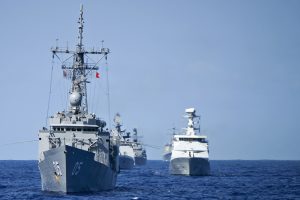Speaking at a New Delhi think tank event on January 11, the outgoing Indonesian ambassador to India announced that his country’s air force will exercise with the Indian Air Force soon, Indian media reported. According to The Print, Ambassador Sidharto Reza Suryodipuro noted at the Aspen Ananta Center, “in terms of military cooperation, we have strengthened from coordinated patrol in the Andaman Sea, that has been going on at least for the past 17 years. We have army-to-army exercises, navy-to-navy, and soon we will start air force to air force [exercise].”
“India and Indonesia now have a shared vision of maritime cooperation in the Indo-Pacific,” Suryodipuro added.
In December, the Indian and Indonesian navies held the 35th edition of the India-Indonesia Coordinated Patrol (IND-INDO CORPAT) which began in 2002. According to an Indian defense ministry statement at that time, the CORPATs have been held “with the aim of ensuring safety and security of shipping and international trade in the region. CORPATs build up understanding and interoperability between navies and facilitate institution of measures to prevent and suppress Illegal Unreported Unregulated (IUU) fishing, drug trafficking, maritime terrorism, armed robbery and piracy.”
India does not participate in joint patrols unless they form part of a United Nations mission.
The two countries began naval exercises, “Samudra Shakti,” in 2018 and held them again in 2019; however, 2020 did not see any India-Indonesia naval exercise. The latest – sixth – iteration of the “Garuda Shakti” exercise between Indian and Indonesian special forces were held in 2018.
While these developments point to a deepening defense relationship between the two countries, they have some way to go in developing a shared understanding of what they ought to do together beyond a fuzzy shared understanding of the threats China poses in the maritime domain.
Speaking to The Diplomat, maritime analyst and former Indian naval officer Abhijit Singh said that Indonesia remains “inherently skeptical of too much maritime cooperation” with India. However, pointing out the Samudra Shakti exercises, Singh noted that “some progress” has been made in that direction.
According to Singh, much of the differences in strategic perception between the two countries has to do with how Indonesia under President Joko “Jokowi” Widodo imagines the value of the seas – as a domain that furthers Indonesia’s economic interests, rather than in strategic terms. Jokowi’s maritime thrust has tilted toward strengthening Indonesia’s coast guard, he added.
India, meanwhile, has keenly looked to developing the Andaman and Nicobar Islands militarily in order to develop capabilities to hold key maritime chokepoints in the region at risk in the event of a shooting war with China.
While Singh admitted that there is growing appreciation of each other’s relative maritime strengths, he pointed out that Indonesia remains considerably cautious about joint operations (with India or any other country) in its strategically vital littoral waters. That said, he noted the growing realization in both countries that the two can do much for each other when it comes to maritime security — and the important role the United States can play in it, despite Indonesia’s time-honored stance of not choosing sides. In the past, between 2015-17 when Indonesia headed the Indian Ocean Rim Association, it had pushed hard for regionalism, consequently downplaying the role of extra-regional powers, Singh noted.
Singh also flagged differences between India and Indonesia when it comes to a common understanding of exclusive economic zones (EEZs) and continental shelf boundary.
India and Indonesia signed a continental shelf boundary agreement – establishing a boundary between the Great Nicobar Island and Sumatra — in August 1974, extending it in 1977 to further cover the Andaman Sea. In the past, Indonesia has asked for a new agreement to delineate EEZs. In a 2018 op-ed, Suryodipuro had emphasized maritime boundary delineation as something both countries needed to focus on in order to further cooperation. “Concluding the EEZ boundary negotiation with India will further enhance bilateral relations between Indonesia and India, as well as strengthen the role of UNCLOS [United Nations Convention for the Law of the Sea] as the ‘Constitution of the Sea’ respected by all in the Indo-Pacific,” he had written.
However, these latent differences are increasingly being downplayed by both sides, as Indonesia seeks trade and investment from India and Jokowi pushes ahead with his economic plans. For now, both countries see fair winds and following seas when it comes to their bilateral relationship.

































